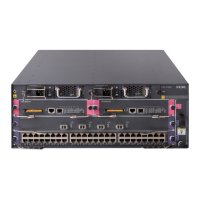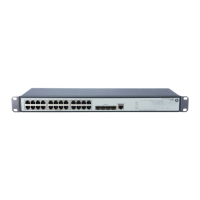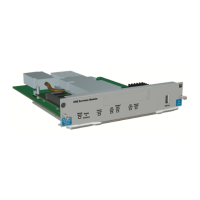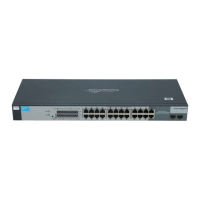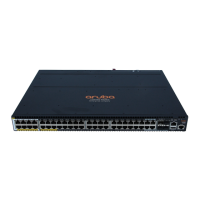26
Common topologies
Although HP recommends using the XPAK stacking ports to achieve the highest cabling efficiency and
bandwidth, you can also create multiple switch configurations using the SFP ports. The HP StorageWorks
SN6000 Fibre Channel Switch switch supports the following topologies using the SFP ports:
• Cascaded fabric topology
• Ring fabric topology
• Meshed fabric topology
• Core-edge fabric topology
For additional information about topologies and Storage Area Network (SAN) connectivity, see the SAN
Design Reference Guide available at the HP website: http://www.hp.com/go/SANdesignguide
.
Transparent routing
IMPORTANT: Simple SAN Connection Manager (SSCM) version 3.0 or later is required for the HP
SN6000 Fibre Channel Switch. The Simple SAN Connection Manager (SSCM) application can manage
H-series switches with active TR_Ports; however, SSCM cannot manage or discover remote switches or
devices in the remote fabric. Use QuickTools or Enterprise Fabric Management Suite and the storage
management interface to present Logical Unit Numbers (LUNs) to remote devices.
\
The transparent routing feature provides inter-fabric routing to allow controlled and limited access between
devices on a SN6000 Fibre Channel Switch (local) fabric and devices on a remote fabric consisting of
B-series or C-series switches. For a list of switches that are supported in a remote fabric, see the HP
StorageWorks SN6000 Fibre Channel Switch Release Notes, and the HP StorageWorks SAN Design
Reference Guide on the HP website: http://www.hp.com/go/sandesignguide
. This type of inter-fabric
connection uses the Fibre Channel industry N-Port ID Virtualization (NPIV), and makes local and remote
devices accessible to each other while maintaining the local and remote fabrics as separate fabrics.
You can connect multiple SN6000 Fibre Channel Switches to one or more remote fabrics using multiple
TR_Ports. Local and remote devices are identified by their respective port worldwide names. Consider the
following mapping rules:
• A TR_Port can support a maximum of 32 local device/remote device mappings.
• A specific local device can be mapped to devices on only one remote fabric. Local devices on the same
SN6000 Fibre Channel Switch can each be mapped to different remote fabrics.
• For mappings between a specific SN6000 Fibre Channel Switch and a remote fabric, each local
device or remote device can be mapped over only one TR_Port. Additional mappings to either device
must use that same TR_Port.
• Multiple local devices connected to different local switches can be mapped to the same remote device
over one TR_Port on each local switch.
• A local device cannot be mapped over an E_Port to another local switch, then over a TR_Port to the
remote device. The local switch to which the local device is connected must connect directly to the
remote fabric over a TR_Port.
NOTE: When a local device is mapped over a TR_Port to a remote device, the local device and its
TR_Port appear as an NPIV connected device in the remote fabric. It is possible, though not
recommended, to map such a local device over a second TR_Port to a local device in a second
local fabric. In this case, if you merge the two local fabrics, the transparent route becomes inactive
for the devices that now have a path over an ISL, and an alarm is generated.

